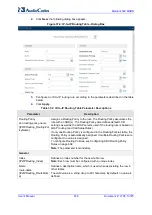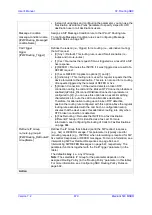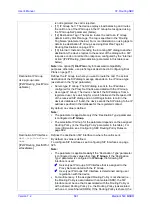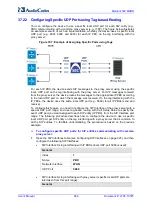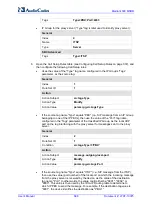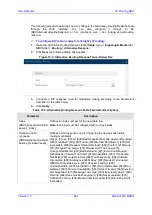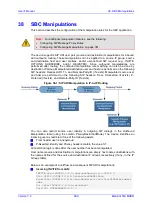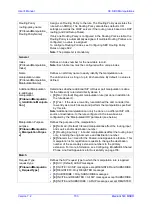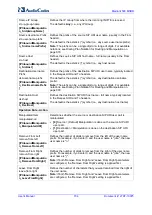
User's Manual
690
Document #: LTRT-10375
Mediant 500 MSBR
37.3 Configuring SIP Response Codes for Alternative
Routing Reasons
The Alternative Routing Reasons table lets you configure up to 20 SIP response codes for
call release (termination) reasons, which then trigger alternative routing. If a call (outgoing
SIP dialog-initiating methods, e.g., INVITE, OPTIONS, and SUBSCRIBE messages) is
released as a result of a configured SIP code (e.g., SIP 406), the device does alternative
routing as follows: If the destination Proxy Set is configured with multiple IP addresses (see
Configuring Proxy Sets on page 348), the device first attempts to route the call to one of
these IP addresses, starting with the first listed address. If unsuccessful, the device then
searches for an alternative routing rule in the IP-to-IP Routing table (see Configuring SBC
IP-to-IP Routing Rules on page 671).
Typically, the device performs alternative routing when there is no response at all to an
INVITE message. This is done after a user-defined number of INVITE re-transmissions,
configured by the SIPMaxRtx parameter. In such a scenario, the device issues itself the
SIP response code 408 (Request Timeout). Alternative routing is only done if you have
configured the response code in the Alternative Routing Reasons table.
You can also configure alternative routing for the following proprietary response codes, if
configured in the table, that are issued by the device itself:
805 IP Profile Call Limit:
The device generates the response code when Call
Admission Control (CAC) limits (e.g., maximum concurrent calls) are exceeded for an
IP Group (or SRD). The CAC rules are configured in the Admission Control table (see
Configuring Admission Control on page 659). When this occurs, the device sends a
SIP 480 (Temporarily Unavailable) response to the SIP entity. In such a scenario, an
alternative route configured in the IP-to-IP Routing table can be used.
806 Media Limits Exceeded:
The device generates the response code when the call
is terminated due to crossed user-defined thresholds of QoE metrics such as MOS,
packet delay, and packet loss (see Configuring Quality of Experience Profiles on page
293) and/or media bandwidth (see Configuring Bandwidth Profiles on page 298).
When this occurs, the device sends a SIP 480 (Temporarily Unavailable) response to
the SIP entity. This is configured by 1) assigning an IP Group a QoE and/or Bandwidth
profile that rejects calls if the threshold is crossed, 2) configuring 806 in the Alternative
Routing Reasons table and 3) configuring an alternative routing rule.
The device also generates the response code when it rejects a call based on Quality
of Service rules due to crossed Voice Quality and Bandwidth thresholds (see
Configuring Quality of Service Rules on page 302). If the response code is configured
in the table and the device rejects a call due to threshold crossing, it searches in the
IP-to-IP Routing table for an alternative routing rule.
818 Signalling Limits Exceeded:
The device generates the response code when it
rejects a call based on Quality of Service rules due to crossed ASR, NER or ACD
thresholds (see Configuring Quality of Service Rules on page 302). If the response
code is configured in the table and the device rejects a call due to threshold crossing,
it searches in the IP-to-IP Routing table for an alternative routing rule.
Note:
•
If the device receives a SIP 408 response, an ICMP message, or no response,
alternative routing is still performed even if the code is not configured in the
Alternative Routing Reasons table.
•
SIP requests belonging to an SRD or IP Group that have reached the call limit
(maximum concurrent calls and/or call rate) as configured in the Call Admission
table are sent to an alternative route if configured in the IP-to-IP Routing table for
the SRD or IP Group. If no alternative routing rule is located, the device
automatically rejects the SIP request with a SIP 480 (Temporarily Unavailable)
response.
Summary of Contents for Mediant 500 MSBR
Page 2: ......
Page 33: ...Part I Getting Started with Initial Connectivity ...
Page 34: ......
Page 36: ...User s Manual 36 Document LTRT 10375 Mediant 500 MSBR This page is intentionally left blank ...
Page 40: ...User s Manual 40 Document LTRT 10375 Mediant 500 MSBR This page is intentionally left blank ...
Page 45: ...Part II Management Tools ...
Page 46: ......
Page 48: ...User s Manual 48 Document LTRT 10375 Mediant 500 MSBR This page is intentionally left blank ...
Page 115: ...Part III General System Settings ...
Page 116: ......
Page 132: ...User s Manual 132 Document LTRT 10375 Mediant 500 MSBR This page is intentionally left blank ...
Page 137: ...Part IV General VoIP Configuration ...
Page 138: ......
Page 290: ...User s Manual 290 Document LTRT 10375 Mediant 500 MSBR This page is intentionally left blank ...
Page 306: ...User s Manual 306 Document LTRT 10375 Mediant 500 MSBR This page is intentionally left blank ...
Page 380: ...User s Manual 380 Document LTRT 10375 Mediant 500 MSBR This page is intentionally left blank ...
Page 454: ...User s Manual 454 Document LTRT 10375 Mediant 500 MSBR This page is intentionallty left blank ...
Page 455: ...Part V Gateway Application ...
Page 456: ......
Page 460: ...User s Manual 460 Document LTRT 10375 Mediant 500 MSBR This page is intentionally left blank ...
Page 484: ...User s Manual 484 Document LTRT 10375 Mediant 500 MSBR This page is intentionally left blank ...
Page 494: ...User s Manual 494 Document LTRT 10375 Mediant 500 MSBR This page is intentionally left blank ...
Page 625: ...Part VI Session Border Controller Application ...
Page 626: ......
Page 654: ...User s Manual 654 Document LTRT 10375 Mediant 500 MSBR This page is intentionally left blank ...
Page 656: ...User s Manual 656 Document LTRT 10375 Mediant 500 MSBR This page is intentionally left blank ...
Page 741: ...Part VII Cloud Resilience Package ...
Page 742: ......
Page 751: ...Part VIII Data Router Configuration ...
Page 752: ......
Page 753: ......
Page 754: ......
Page 756: ...User s Manual 756 Document LTRT 10375 Mediant 500 MSBR This page is intentionally left blank ...
Page 757: ...Part IX Maintenance ...
Page 758: ......
Page 834: ...User s Manual 834 Document LTRT 10375 Mediant 500 MSBR This page is intetnionaly left blank ...
Page 837: ...Part X Status Performance Monitoring and Reporting ...
Page 838: ......
Page 848: ...User s Manual 848 Document LTRT 10375 Mediant 500 MSBR This page is intentionally left blank ...
Page 852: ...User s Manual 852 Document LTRT 10375 Mediant 500 MSBR This page is intentionally left blank ...
Page 854: ...User s Manual 854 Document LTRT 10375 Mediant 500 MSBR This page is intentionally left blank ...
Page 878: ...User s Manual 878 Document LTRT 10375 Mediant 500 MSBR This page is intentionally left blank ...
Page 880: ...User s Manual 880 Document LTRT 10375 Mediant 500 MSBR This page is intentionally left blank ...
Page 926: ...User s Manual 926 Document LTRT 10375 Mediant 500 MSBR This page is intentionally left blank ...
Page 927: ...Part XI Diagnostics ...
Page 928: ......
Page 950: ...User s Manual 950 Document LTRT 10375 Mediant 500 MSBR This page is intentionally left blank ...
Page 954: ...User s Manual 954 Document LTRT 10375 Mediant 500 MSBR This page is intentionally left blank ...
Page 956: ...User s Manual 956 Document LTRT 10375 Mediant 500 MSBR This page is intentionally left blank ...
Page 958: ...User s Manual 958 Document LTRT 10375 Mediant 500 MSBR This page is intentionally left blank ...
Page 974: ...User s Manual 974 Document LTRT 10375 Mediant 500 MSBR This page is intentionally left blank ...
Page 976: ...User s Manual 976 Document LTRT 10375 Mediant 500 MSBR This page is intentionally left blank ...
Page 977: ...Part XII Appendix ...
Page 978: ......
Page 982: ...User s Manual 982 Document LTRT 10375 Mediant 500 MSBR This page is intentionally left blank ...

